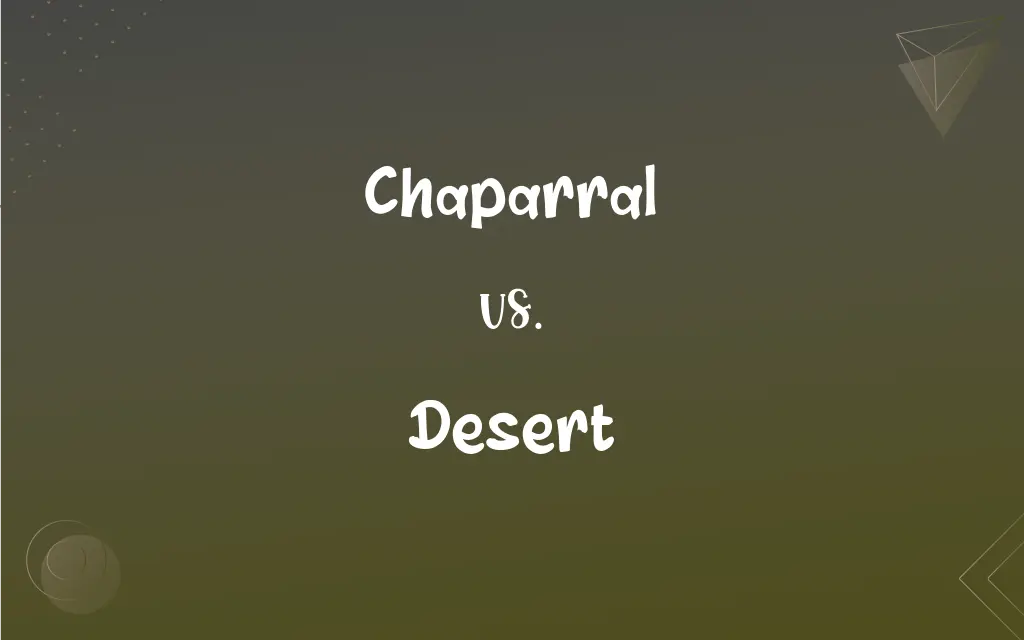Chaparral vs. Desert: What's the Difference?
By Janet White || Updated on May 29, 2024
Chaparral features dense, woody shrubs and mild, wet winters with hot, dry summers, while deserts are characterized by sparse vegetation and extremely arid conditions.

Key Differences
Chaparral is a biome characterized by dense, woody shrubs and small trees, thriving in regions with mild, wet winters and hot, dry summers. This biome is often found in Mediterranean climates, supporting a unique ecosystem adapted to periodic wildfires. Desert biomes, on the other hand, are defined by their extreme aridity, receiving less than 10 inches of rainfall annually. The sparse vegetation in deserts is adapted to conserve water and withstand extreme temperatures.
In chaparral regions, the flora is adapted to survive frequent fires, with many plants having hard, waxy leaves to reduce water loss. Deserts, conversely, have plants like cacti and succulents, which store water in their tissues and have reduced leaf surfaces to minimize transpiration. Both biomes host unique fauna, with chaparral supporting animals that can escape fires, while desert animals are adapted to survive with minimal water.
Chaparral ecosystems experience a distinct seasonal pattern, with most precipitation occurring in winter. This seasonality supports a different plant and animal lifecycle compared to deserts, which have less predictable and infrequent rainfall. Desert species often have longer dormancy periods, activating only during brief wet spells.
Chaparral regions are more susceptible to human impacts such as urban development and agriculture, which can alter fire regimes and biodiversity. Deserts are also impacted by human activities like off-road driving and water extraction, which can disrupt fragile ecosystems and lead to desertification.
Comparison Chart
Climate
Mild, wet winters; hot, dry summers
Extremely arid, very low rainfall
ADVERTISEMENT
Vegetation
Dense, woody shrubs and small trees
Sparse vegetation, mainly cacti and succulents
Adaptation to Fire
Plants adapted to survive periodic wildfires
Minimal fire adaptation, focus on water conservation
Seasonal Patterns
Distinct wet and dry seasons
Irregular and infrequent rainfall
Human Impact
Urban development, agriculture altering fire regimes
Off-road driving, water extraction leading to desertification
Chaparral and Desert Definitions
Chaparral
A biome characterized by dense, spiny shrubs.
The chaparral biome is commonly found in California.
ADVERTISEMENT
Desert
Ecosystems adapted to conserve water.
Animals in the desert often are nocturnal to avoid daytime heat.
Chaparral
Regions with mild, wet winters and hot, dry summers.
The chaparral climate supports unique flora and fauna.
Desert
Areas receiving less than 10 inches of rainfall annually.
Deserts have unique flora and fauna adapted to harsh conditions.
Chaparral
Ecosystems found in Mediterranean climates.
Chaparral regions often border coastal areas.
Desert
A dry, often sandy region of little rainfall, extreme temperatures, and sparse vegetation.
Chaparral
Vegetation adapted to periodic wildfires.
Plants in the chaparral have adapted to survive wildfires.
Desert
A region of permanent cold that is largely or entirely devoid of life.
Chaparral
Biomes supporting hard, waxy-leaved plants.
Chaparral vegetation is typically drought-resistant.
Desert
An apparently lifeless area of water.
Chaparral
An area covered by a dense growth of mostly small-leaved evergreen shrubs, especially in central and southern California.
Desert
An empty or forsaken place; a wasteland
A cultural desert.
Chaparral
(US) A region of shrubs, typically dry in the summer and rainy in the winter. The coast of the Mediterranean is such a region.
Desert
(Archaic) A wild and uninhabited region.
Chaparral
The foliage of creosote bush, Larrea divaricata, when used as a medicinal herb.
Desert
Often deserts Something that is deserved or merited, especially a punishment
They got their just deserts when the scheme was finally uncovered.
Chaparral
A thicket of low evergreen oaks.
Desert
The state or fact of deserving reward or punishment.
Chaparral
An almost impenetrable thicket or succession of thickets of thorny shrubs and brambles.
Desert
Of, relating to, characteristic of, or inhabiting a desert
Desert fauna.
Chaparral
Dense vegetation consisting of stunted trees or bushes
Desert
Wild and uninhabited
A desert island.
Desert
To leave empty or alone; abandon.
Desert
To withdraw from, especially in spite of a responsibility or duty; forsake
Deserted her friend in a time of need.
Desert
To abandon (a military post, for example) in violation of orders or an oath.
Desert
To forsake one's duty or post, especially to be absent without leave from the armed forces with no intention of returning.
Desert
That which is deserved or merited; a just punishment or reward.
Desert
A barren area of land or desolate terrain, especially one with little water or vegetation; a wasteland.
Desert
(figuratively) Any barren place or situation.
Desert
Usually of a place: abandoned, deserted, or uninhabited.
They were marooned on a desert island in the Pacific.
Desert
To leave (anything that depends on one's presence to survive, exist, or succeed), especially when contrary to a promise or obligation; to abandon; to forsake.
You can't just drive off and desert me here, in the middle of nowhere.
Desert
To leave one's duty or post, especially to leave a military or naval unit without permission.
Anyone found deserting will be punished.
Desert
That which is deserved; the reward or the punishment justly due; claim to recompense, usually in a good sense; right to reward; merit.
According to their deserts will I judge them.
Andronicus, surnamed PiusFor many good and great deserts to Rome.
His reputation falls far below his desert.
Desert
A deserted or forsaken region; a barren tract incapable of supporting population, as the vast sand plains of Asia and Africa which are destitute of moisture and vegetation.
A dreary desert and a gloomy waste.
Desert
A tract, which may be capable of sustaining a population, but has been left unoccupied and uncultivated; a wilderness; a solitary place.
He will make her wilderness like Eden, and her desert like the garden of the Lord.
Before her extendedDreary and vast and silent, the desert of life.
Desert
Of or pertaining to a desert; forsaken; without life or cultivation; unproductive; waste; barren; wild; desolate; solitary; as, they landed on a desert island.
He . . . went aside privately into a desert place.
Full many a flower is born to blush unseen,And waste its sweetness on the desert air.
Desert
To leave (especially something which one should stay by and support); to leave in the lurch; to abandon; to forsake; - implying blame, except sometimes when used of localities; as, to desert a friend, a principle, a cause, one's country.
Desert
To abandon (the service) without leave; to forsake in violation of duty; to abscond from; as, to desert the army; to desert one's colors.
Desert
To abandon a service without leave; to quit military service without permission, before the expiration of one's term; to abscond.
The soldiers . . . deserted in numbers.
Desert
An arid region with little or no vegetation
Desert
Leave someone who needs or counts on you; leave in the lurch;
The mother deserted her children
Desert
Desert (a cause, a country or an army), often in order to join the opposing cause, country, or army;
If soldiers deserted Hitler's army, they were shot
Desert
Located in a dismal or remote area; desolate;
A desert island
A godforsaken wilderness crossroads
A wild stretch of land
Waste places
Desert
A barren area with very low precipitation.
The Sahara is the largest hot desert in the world.
Desert
Biomes characterized by extreme aridity.
Deserts can be hot like the Mojave or cold like the Gobi.
Desert
Regions with sparse vegetation and extreme temperatures.
Desert plants like cacti store water in their tissues.
FAQs
How do chaparral plants survive wildfires?
Chaparral plants are adapted to periodic wildfires, often with hard, waxy leaves to reduce water loss and survive fire damage.
What defines a desert biome?
A desert biome is defined by its extreme aridity, with less than 10 inches of annual rainfall and sparse vegetation.
What kind of climate supports chaparral biomes?
Mediterranean climates with mild, wet winters and hot, dry summers support chaparral biomes.
What are the seasonal patterns in chaparral ecosystems?
Chaparral ecosystems have distinct wet winters and dry summers.
What type of vegetation is common in chaparral regions?
Dense, woody shrubs and small trees are common in chaparral regions.
How do desert plants minimize transpiration?
Desert plants often have reduced leaf surfaces and specialized structures to minimize water loss.
What human activities impact chaparral regions?
Urban development and agriculture can alter fire regimes and biodiversity in chaparral regions.
What is the primary climate difference between chaparral and desert?
Chaparral has mild, wet winters and hot, dry summers, while deserts are extremely arid with very low rainfall.
How do plants in deserts adapt to their environment?
Desert plants often store water in their tissues and have reduced leaf surfaces to minimize water loss.
How does fire adaptation differ between chaparral and desert plants?
Chaparral plants are adapted to periodic wildfires, while desert plants focus on water conservation rather than fire survival.
How does rainfall in deserts compare to chaparral regions?
Deserts receive significantly less rainfall, typically less than 10 inches annually, compared to chaparral regions.
How do animals in deserts survive with minimal water?
Many desert animals are nocturnal to avoid daytime heat and have adaptations to minimize water loss.
What impact does urban development have on chaparral?
Urban development can disrupt natural fire cycles and threaten biodiversity in chaparral regions.
What adaptations help desert animals conserve water?
Desert animals often have efficient kidneys and behaviors like burrowing to stay cool and conserve water.
What type of leaf adaptation is common in chaparral plants?
Chaparral plants commonly have hard, waxy leaves to reduce water loss.
Can deserts support any form of vegetation?
Yes, deserts support vegetation like cacti and succulents that are highly adapted to conserve water.
What is the role of fire in chaparral ecosystems?
Fire plays a crucial role in maintaining the health and regeneration of chaparral ecosystems.
What types of animals are commonly found in chaparral biomes?
Animals that can escape fires, such as birds and small mammals, are common in chaparral biomes.
Are there cold deserts?
Yes, deserts can be cold, like the Gobi Desert, with harsh, arid conditions.
What challenges do deserts face due to human activities?
Deserts face challenges like off-road driving and water extraction, which can lead to habitat degradation and desertification.
About Author
Written by
Janet WhiteJanet White has been an esteemed writer and blogger for Difference Wiki. Holding a Master's degree in Science and Medical Journalism from the prestigious Boston University, she has consistently demonstrated her expertise and passion for her field. When she's not immersed in her work, Janet relishes her time exercising, delving into a good book, and cherishing moments with friends and family.































































